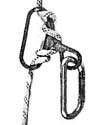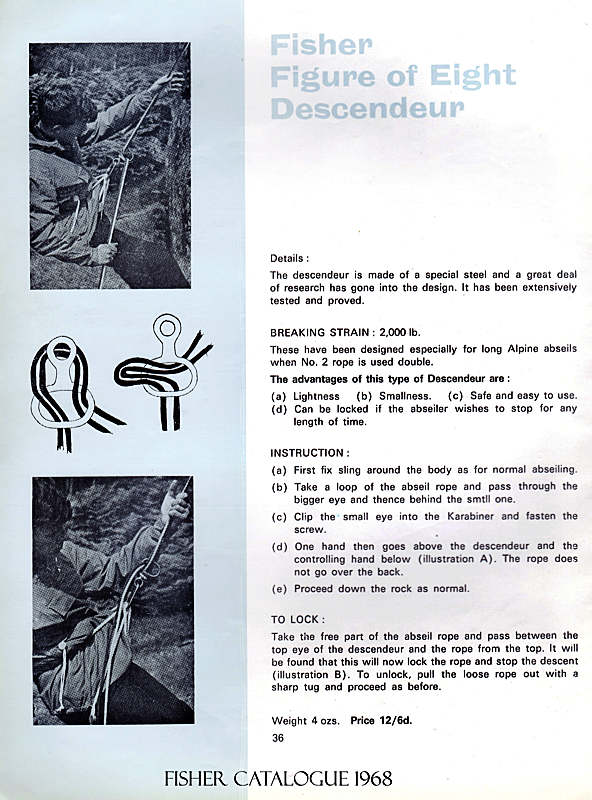Overview
[ Top
| Version A Stamped
| Version A Chrome
| Version B
| Version C
| Return to Figure Eights
]
Version A
(#982, 3119)
Technical Details
I acquired one eight from John Gardner in 2005, and a second from eBay seller old_desert_trader in 2021.
The Fisher, Version A is made from a length of quarter-inch
(6.45 mm.) steel rod bent into shape and welded, then plated.
Mine is 138 mm. tall, 59 mm. wide, and 9 mm. thick.
The rope hole is 53 mm. high and 46 mm. wide. The top center
thickness is 6 mm. The shaft length and width are 36 mm
and 12 mm., respectively. The eye measures 38 mm. by
33 mm. My eight weighs 92 g.
There are no markings on this eight.
 This
is one of the few commercial welded
steel rod figure eights. I think that this is a Fisher Eight for the following reasons:
This
is one of the few commercial welded
steel rod figure eights. I think that this is a Fisher Eight for the following reasons:
- It matches an old
advertisement† that I have.
- I know the one from John Gardner was originally
purchased retail in the U. K. at the same time as Version B, which also appears to be a Fisher eight.
Still, there are no markings to help prove this is a Fisher Eight. This eight is very similar to an eight that came from Black’s in the UK. I list that eight as Blacks Eight, Version A, but it is likely that both were made by the same manufacturer. They could both be Fisher Eights, or they could both be Blacks.
The Fisher was one of the earliest figure eights, perhaps second only to the Schuster's eight. My Fisher,
Version A is lighter than most figure eights. The welded-rod
construction has fallen out of favor, and I wouldn't use this
eight at this time. The back side of the one received from John Gardner is rusted, indicating
that it was stored sitting on a damp surface, but it still appears
strong enough. I just don't like the thin steel construction -
it places too sharp a bend on the rope and lacks sufficient heat
dissipation capability for my taste.
†The advertisement
came from the June 1963 issue of Mountain Craft. Many thanks to
Stéphane Pennequin of Corsica for sending me this.
[ Top
| Version A
| Version A Chrome
| Version B
| Version C
| Return to Figure Eights
]
Version A, Stamped
(#4025)
Technical Details
I acquired this eight from Miles Bradshaw in 2025.
This eight is made from a length of quarter-inch
(6.45 mm.) steel rod bent into shape and welded, then plated.
Mine is 139 mm. tall, 60 mm. wide, and 8 mm. thick.
The rope hole is 52 mm. high and 46 mm. wide. The top center
thickness is 6 mm. The shaft length and width are 36 mm
and 13 mm., respectively. The eye measures 38 mm. by
33 mm. This eight weighs 91 g.
There is an "8" stamped into the shaft weld on each side of this eight.
The "8" stamped on each side of this shaft puzzles me. I do not know why it is there. Perhaps it is a date code (possibly 1968) or a manufacturing lot number. I've listed this eight as a subsidiary version in case it is a manufacturer's mark, but perhaps it is not. Maybe some person, club, or organization owned several of these and numbered them. Perhaps someone needed the mark to know that this was an eight. I simply do not know.
I also don't know why the "8" is stamped on both sides of the eight. One would seem to be sufficient for any of the reasons that I can think of.
[ Top
| Version A
| Version A Stamped
| Version B
| Version C
| Return to Figure Eights
]
Version A, Chrome Plated
(#3329)
Technical Details
I acquired this chrome plated Fisher eight on eBay from Barry J. Rousey in 2023.
This eight is made from a length of quarter-inch
(6.45 mm.) steel rod bent into shape and welded, then chrome plated.
It is 141 mm. tall, 59 mm. wide, and 9 mm. thick. The rope hole is 51 mm. high and 45 mm. wide. The top center thickness is 7 mm. The shaft length and width are 38 mm. and 14 mm., respectively. The eye measures 37 mm. by 33 mm. My eight weighs 109 g.
There are no markings on this eight.
Barry found this eight and several other vertical caving devices in the bottom of a box of rope that he bought at a garage sale in Knoxville TN. It is obvious from the selection that the original owner was a caver, but I have not identified who (s)he was. In any case, it appears that (s)he had this Fisher eight chrome plated to improve its wear resistance. It shows no signs of subsequent use.
[ Top
| Version A
| Version A Stamped
| Version A Chrome
| Version C
| Return to Figure Eights
]
Version B
(#983, 3197, 3142, 3227)
Technical Details
I acquired this eight from John Gardner in 2005. I acquired another from Stan Salmon on eBay in 2012 and gave it to Stéphane Pennequin of the Nut Museum. In 2022, I acquired a second one for myself from Ken ___ on eBay. Later that year, I obtained another from Vintage Climbing.
Version B is 107 mm.
tall, 73 mm. wide, and 9 mm. thick. The rope hole is
36 mm. high and 58 mm. wide. The top center thickness is 9 mm.
The shaft length and width are 35 mm. and 16 mm., respectively.
The eye measures 19 mm. by 19 mm. My eight weighs 143 g.
There are no markings on this eight.
 I'm
fairly certain that this is also a Fisher Eight, since (1) it
matches an old photograph (shown here) that Stéphane Pennequin
of Corsica sent me, and (2) I know it was originally purchased
retail in the U. K. Once again, though, there are no markings to
prove this. The picture came from Mountaineering, from Hill
Walking to Alpine Climbing by Alan Blackshaw, 1968.
I'm
fairly certain that this is also a Fisher Eight, since (1) it
matches an old photograph (shown here) that Stéphane Pennequin
of Corsica sent me, and (2) I know it was originally purchased
retail in the U. K. Once again, though, there are no markings to
prove this. The picture came from Mountaineering, from Hill
Walking to Alpine Climbing by Alan Blackshaw, 1968.
The Fisher, Version B Fisher is a usable eight, although
it is small for my taste and the bronze construction makes it
heavy for its size. The rope hole is shorter than normal, so it
may provide too much friction on stiff or muddy ropes. Its heat
dissipation capability is good, but the small size leads to too
much friction on dirty caving ropes. The eye is too narrow to
accept two full size locking carabiners.
My first Fisher, Version B initially appeared to be
cut from a piece of 8.8 mm. bronze plate, but upon closer inspection, I saw that it was cast. The cut and finish are imprecise,
indicating that it may have been hand finished. The second one is definitely cast and has much better workmanship.
The following catalog page is for a steel Fisher eight shaped like this one. The other Fisher eights are steel, but all the Fisher eights with this shape that I've seen were are made of bronze. Some people have suggested that it is brass rather than bronze, but I'm not convinced. I should be able to easily tell the difference by drilling a hole through one and looking at the chips, or performing chemical (nitric acid) tests on filings, but I'm not willing to destroy one of my Fisher eights to find out.
Without expensive equipment (x-ray fluorescence), there are not many reliable non-destructive ways to tell the between bronze and brass. Density is easy to measure, but he densities of bronze and brass vary depending on the alloy and there is considerable overlap in their respective ranges. I measured the density of my eight by weighing the eight in and out of water, and calculated the density as 7.45 g/cm3. This is lower than that of typical tin-based bronze or brass, but is almost an exact fit for aluminum bronze. The eight's color can match aluminum bronze as well, so perhaps that is the alloy used. The strength and corrosion resistance of aluminum bronze would make it a desirable choice.
[ Top
| Version A
| Version A Stamped
| Version A Chrome
| Version B
| Return to Figure Eights
]
Version C
(#1011)
Technical Details
Andrzej Mistela donated this figure eight in 2006.
The Fisher, Version C is made from steel, perhaps in two
pieces. The upper rope hole may have been a piece of 5/16-inch
steel rod that was bent into a "C" shape and welded
to the shank. The cut and finish of the shank and eye are imprecise,
indicating that this portion may have been hand cut. Mine is 128
mm tall, 130 mm. wide, and 10 mm. thick. The rope hole
is 38 mm. high and 114 mm. wide. The top center thickness
is 9 mm. The shaft length and width are 58 mm. and 16 mm.,
respectively. The eye measures 20 mm. by 20 mm. My eight
weighs 210 g.
There are no markings on this eight.
 This
is another one of the few commercial welded
steel rod figure eights. This eight matches the "rope
brake Fisher" shown in figure 3 of Tomaz Planina’s 1976 article
(Obraba vrvi pri spuscanju z vrvnimi zavorami, Nase
jame, 17, 1976, pp. 15-22; "Climbing ropes wearing out with
rope brakes," Nase jame, 19, 1977, pp. 15-22) ending my earlier
speculation as to whether Mr. Planina’s "Fisher" was
an original or a copy. Incidentally, the double wrap shown in
the figure was a nonstandard rigging designed to help keep the
eight from slipping in Tomaz Planina’s tests. Don't take this
as a rigging suggestion.
This
is another one of the few commercial welded
steel rod figure eights. This eight matches the "rope
brake Fisher" shown in figure 3 of Tomaz Planina’s 1976 article
(Obraba vrvi pri spuscanju z vrvnimi zavorami, Nase
jame, 17, 1976, pp. 15-22; "Climbing ropes wearing out with
rope brakes," Nase jame, 19, 1977, pp. 15-22) ending my earlier
speculation as to whether Mr. Planina’s "Fisher" was
an original or a copy. Incidentally, the double wrap shown in
the figure was a nonstandard rigging designed to help keep the
eight from slipping in Tomaz Planina’s tests. Don't take this
as a rigging suggestion.
This eight is slightly heavy for my taste. Steel will wear
well, but does not conduct heat as well as aluminum does. It also
rusts. The apparent welds do not appear to be sound enough to
elicit my full trust.
The rod forming the rope hole is a bit thin for my taste, and
it bends the rope accordingly. The rope hole is shorter and wider
than normal, but it sits at an angle. The asymmetric rope hole
is interesting, but I find that it helps exaggerate the tendency
that all eights have to induce spinning on free drops. The eye
is too narrow to accept two full size locking carabiners.
[ Top
| Version A
| Version A Stamped
| Version A Chrome
| Version B
| Version C
]



